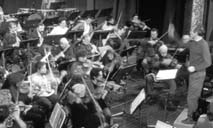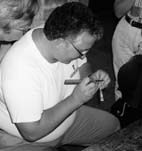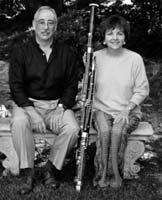
After four years of increasing concern about the plight of the people of Bosnia, Marianne Liberatore last spring rallied Connecticut's South Shore Music Festival, a violin maker, the good townspeople of Fairfield and Westport, an abbey of nuns in Farfa, Italy, the Yamaha Corporation, and dozens of others to assist in restoring the Sarajevo Philharmonic Orchestra. This is her story.
As she was feeling most helpless about making a difference for the people of once-beautiful Sarajevo, and especially for the musicians there, Marianne Liberatore '48 heard a National Public Radio account of the wartime travails of the Sarajevo Philharmonica and their brave efforts to restart their musical lives. As president and program director of the South Shore Summer Music Festival, she was determined to explore what she and the group could do, and began her dedicated quest for ways to support the orchestra.
When NPR provided the phone number for the orchestra, Marianne's first move was to telephone the orchestra director and first clarinetist, Emir Nuhanovic, to express her desire to help. His letter, in reply, was a heart-breaker:
Dear Mrs. Liberatore and friends from the South Shore Music Festival,
The past four years were very difficult, and had a devastating effect on our orchestra as well as on the whole city of Sarajevo. Looking back, it seems impossible to live here, not to speak of performing concerts. However, in spite of the extreme conditions, musicians continued to play . . . Music helped the people of Sarajevo to stay sane, to have more strength to endure all the hardships, to forget for the moment what is happening to their city and to them. The Hall was never so full before the war as it was during it. Audience didn't care for the cold or the bombing of the city. It didn't matter that they would sit in coats trembling just like the musicians, music was what mattered.
The performances were in cold halls with temperature below zero, with candles as the only light. People from the audience used to hold candles on the concerts so that the musicians could see music parts.
On one occasion mortar shell hit the building of the National Theater just 30 feet from the window of the rehearsing room, but musicians continued rehearsals and they performed that concert with Barbara Hendricks as a soloist. That time nobody was hurt, but unfortunately during the war, seven of them were killed and 12 wounded.
We lost a lot of instruments that burned down in a fire caused by the bomb. Some of them are destroyed and damaged by schrapnells. We also lost scores and orchestra parts. Some musicians left Sarajevo so we included students and retired musicians with the only goal that Sarajevo Philharmonic Orchestra must not stop its activity . . . We are proud to say that Sarajevo Philharmonic Orchestra performed over 40 concerts with 20 repeat concerts. Maybe if there was more music, this war would never happened.
We still have a lot of difficulties. We need instruments, scores, we need funds for the work, but we are determined that Sarajevo Philharmonic Orchestra must continue to work and with the help of friends we can go on.
Thank you for your kind offer to help us. Perhaps music and culture can finally change the minds of people and somehow make the wars stop.
Sincerely,
Emir Nuhanovic, Director
The letter was accompanied by a list of instruments most urgently needed-"a Clarinet in Si, a Clarinet in La, a Yamaha Piccolo Flute in Do, an Oboe, Fagots [bassoons] and a Loree English horn." With the shopping list in hand, Marianne and the South Shore group began the daunting task of not only locating the instruments, but finding a way to pay for them. 
The Yamaha Corporation responded to their appeal by promptly and generously contributing a clarinet in A. South Shore's board of directors swiftly appropriated funds from their very modest treasury to purchase the clarinet in B-flat. Marianne contacted Dorothy Darlington, a professional oboist in New York City, for her ideas for locating an oboe, and Dorothy put together a subscription program with Barbara Newington and the Benedictine Grange of West Redding, Connecticut, resulting in the purchase of a fine Rigoutat oboe for the Sarajevans.
The three instruments were delivered to the orchestra by a rather circuitous route-Marianne took them along to Vienna during a South Shore "musical odyssey" to Europe, and personally presented them at the American ambassador's Viennese residence March 8, 1996. They were ceremoniously received there by maestro Charles Ansbacher, a guest conductor of the Sarajevo Philharmonica.
Three down, and now, only the piccolo, the English horn, and the bassoon to go-or so it seemed. Within only a few months, South Shore raised the funds and acquired the Loree English horn, the bassoon, a silver flute, three fine bows for stringed instruments, and a specially commissioned orchestral score featuring the new instruments.
Marianne had discovered that the entire string section's instruments were in deplorable condition. Some needed replacement, and all needed restoration and repair. Where would the money come from? The "Save the Sarajevo Strings" campaign, an outgrowth of the "Woodwinds for Sarajevo" project, was immediately initiated.
The Italian government had invited the Sarajevans to be the orchestra-in-residence for the Farfa Giubileo Festival in the abbey town of Farfa for the last two weeks of August 1996. Phillip Injeian, owner of the New York Violin Shop and member of South Shore's advisory council, flew to Italy at the group's expense to join the orchestra and restore the strings. The orchestra members, along with Injeian and Marianne, were housed in a mountain-top convent, home to an order of Franciscan nuns who had taken a perpetual vow of silence. Because so much zestful music emerged at all hours from Injeian's workshop as he and the musicians sampled the results of his painstaking efforts, the nuns wordlessly indicated that the group must pack up and move to an outbuilding further away from the area where the nuns were trying to conducted their noiseless worship.
In just two weeks, working day and night, and sometimes all night long, Injeian singlehandedly restored every violin, viola, cello and double bass-and all the bows. Marianne watched with fascination as he patched and restored everything: new strings, bridges, soundposts, pegs, planing of the finger boards, and total restoration of the cases. One of his tasks was restoring the case of a cello that had been shattered by a sniper's bullet. When the cellist discovered her instrument repaired and polished, she turned to Injeian and said, "But I can't pay you for this." He assured her that there was no charge for his work; that the cello had saved her life, and now he had saved the cello's. She promptly dissolved in tears of joy.
On October 4, 1996, a benefit featuring Romanian-born virtuoso violinist Sergui Schwartz was staged by South Shore. With the $22,000 raised by the concert a fine French violin (Georges Cunault 1908) and bow were presented to the orchestra in November. The remainder of the funds was used to engage Schwartz this past March. He traveled to Sarejevo where he was the orchestra's featured soloist at the XIII International Sarajevo Winter Festival's concluding concert, and stayed on to work with the musicians, preparing for their very first CD recording. 
Today the once-proud orchestra is a chamber ensemble of about 45 musicians, some of whom who live outside the city and travel a considerable distance to play scheduled concert engagements. Many former orchestra members permanently fled the capital during the war, and many of their chairs are now occupied by young and inexperienced musicians. Among the biographies of performers the director sent to Marianne was this one from bassoonist Rasko Zivkovic:
Born in 1966 in Sarajevo. My background is working class. Nobody in my family was a musician except for one distant ancestor who earned 20 square kilometres of land playing on violin. I am working with music since I know of myself. Once I had seen one show on TV about bassoon, and I liked that instrument. Bassoon is very interesting and has a peculiar color of tone. I performed on it during my studies and I especially remember I once received a chocolate from one composer for playing his composition so good. Unfortunately since I have no means to buy bassoon I was not able to study bassoon class on music Academy so I was on class for composition. During the war Mr. Emir Nohanvic gave me a chance to play in Sarajevo Philharmonics and he provide me with instrument and place to rehearse. Since then I play in orchestra. My wish is to play first bassoon but I lack in technical skill in long arias. My instrument is also very weak and ruined almost unusable. However my wish is to continue to play and also to be excellent in it.
What so captured Marianne's ardent attention? Why have so many people in so many countries responded so enthusiastically to the needs of this valiant orchestra? The reason may be that the orchestra's perseverance throughout the war, performing in the midst of chaos and deprivation, provided a beacon of hope-or, perhaps that the orchestra is seen as a living example of returning civility in the region, with Croats, Serbs, and Hungarians—Muslims, Jews, and and Christians-all harmoniously and earnestly working and playing together.
All photographs courtesy of Marianne Liberatore
Return to the OAM Spring 1997 Table of Contents